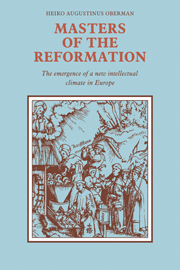Book contents
- Frontmatter
- Contents
- Preface
- Abbreviations
- Map
- PART I INTELLECTUAL RENEWAL
- PART II THE GRAPES OF WRATH
- 7 A theology of turmoil: the ferment of ideas
- 8 The ethics of capitalism: the clash of interests
- 9 The power of witchcraft: devil and devotion
- PART III NEW JERUSALEM WITHIN THE OLD WALLS
- Student population at German universities 1385–1540
- Chronological outline
- Bibliography
- Index of names and places
- Index of modern authors
- Subject index
9 - The power of witchcraft: devil and devotion
Published online by Cambridge University Press: 07 October 2011
- Frontmatter
- Contents
- Preface
- Abbreviations
- Map
- PART I INTELLECTUAL RENEWAL
- PART II THE GRAPES OF WRATH
- 7 A theology of turmoil: the ferment of ideas
- 8 The ethics of capitalism: the clash of interests
- 9 The power of witchcraft: devil and devotion
- PART III NEW JERUSALEM WITHIN THE OLD WALLS
- Student population at German universities 1385–1540
- Chronological outline
- Bibliography
- Index of names and places
- Index of modern authors
- Subject index
Summary
Centuries of pseudo-historical propaganda have acquainted us with the image of a medieval Mater Ecclesia and her handmaiden Theologia straying benighted into a dead-end street on the dark and frozen eve of the Reformation; a plight from which true religion was miraculously guided into the dawn of the modern era by the morning star of the wise men of Wittenberg. The chief exhibit in the Reformation hall of heroics has consisted, on the one hand, of a Protestant tableau portraying the breathtaking descent of Truth into a hostile late medieval terrain devoid of historical points of contact. But the exhibition displays other scenes also. Indeed, the opposite wall of the Reformation gallery has been refitted only in recent decades with the so-called ecumenical image of Luther.
Although drawn from another perspective, the new ecumenical portrait carries the same message and only confirms its Protestant counterpart. Its Catholic predecessor in the exhibit – cracked, faded and above all, out of style – had been masterfully painted by Heinrich Denifle. Denifle had portrayed Luther's Reformation as a smokescreen for his libido, as if Luther had tried to legitimize his insurmountable and incessant concupiscence with the doctrine of the sinner's justification sola fide, freeing him from his Anfechtungen to marry Catherine von Bora. In contrast, the new Catholic portrait honours Luther – and modern Catholics show themselves particularly indebted to Joseph Lortz – by depicting him as an ‘earnest and devout man of prayer’.
- Type
- Chapter
- Information
- Masters of the ReformationThe Emergence of a New Intellectual Climate in Europe, pp. 158 - 184Publisher: Cambridge University PressPrint publication year: 1981

